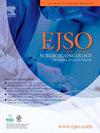Risk factors for lymph node metastasis and survival: Toward better endoscopic selection in ulcerative versus nonulcerative early gastric cancer
IF 2.9
2区 医学
Q2 ONCOLOGY
引用次数: 0
Abstract
Background
Lymph node metastasis (LNM) is a major determinant of patient outcomes in early gastric cancer (EGC) patients. This study aimed to identify risk factors for LNM and compare outcomes between patients with ulcerative EGC (UEGC) and with nonulcerative EGC (NUEGC).
Methods
We retrospectively analyzed the data of 1262 patients with pathologically confirmed EGC who underwent curative gastrectomy. The risk factors for LNM and overall survival (OS) were assessed. OS was estimated with Kaplan‒Meier analysis, and prognostic factors were identified via Cox regression analysis.
Results
LNM was significantly more common in the UEGC group (16.6 %) than in the NUEGC group (11.6 %) (P = 0.013). According to the multivariable analysis, lymphovascular invasion (LVI) (OR = 17.609, P < 0.001 for NUEGC; OR = 14.587, P < 0.001 for UEGC), superficial submucosal (SM1) invasion (OR = 2.622, P = 0.045 for NUEGC; OR = 2.276, P = 0.022 for UEGC), and deep submucosal (SM2) invasion (OR = 3.276, P = 0.004 for NUEGC; OR = 3.132, P = 0.001 for UEGC) were independent predictors of LNM in both groups, whereas a tumor size>30 mm (OR = 2.644, P = 0.009) was a significant factor only for NUEGC patients. The 5-year OS rate was 89.9 % in the NUEGC group and 87.2 % in the UEGC group (P = 0.028, log-rank test). LNM was an independent predictor of OS in both subtypes of EGC, whereas elevated carcinoembryonic antigen (CEA) levels and SM2 invasion were significant predictors only for UEGC patients.
Conclusion
Compared with NUEGC, UEGC presents more aggressive pathological features and is characterized by a significantly higher rate of LNM and worse long-term patient survival, while undifferentiated UEGC <2 cm potentially supports ESD expansion.
淋巴结转移和生存的危险因素:溃疡性与非溃疡性早期胃癌更好的内镜选择
背景:淋巴结转移(LNM)是早期胃癌(EGC)患者预后的主要决定因素。本研究旨在确定LNM的危险因素,并比较溃疡性EGC (UEGC)和非溃疡性EGC (NUEGC)患者的预后。方法回顾性分析1262例经病理证实的胃癌患者行根治性胃切除术的资料。评估LNM和总生存期(OS)的危险因素。Kaplan-Meier分析估计OS, Cox回归分析确定预后因素。结果UEGC组slnm发生率(16.6%)显著高于NUEGC组(11.6%)(P = 0.013)。根据多变量分析,淋巴血管侵犯(LVI) (OR = 17.609, NUEGC为P <; 0.001; OR = 14.587, UEGC为P <; 0.001)、粘膜下浅层(SM1)侵犯(OR = 2.622, NUEGC为P = 0.045; OR = 2.276, UEGC为P = 0.022)、粘膜下深层(SM2)侵犯(OR = 3.276, NUEGC为P = 0.004;对于UEGC, OR = 3.132, P = 0.001)是两组中LNM的独立预测因素,而肿瘤大小>;30 mm (OR = 2.644, P = 0.009)仅是NUEGC患者的重要因素。NUEGC组5年OS率为89.9%,UEGC组为87.2% (P = 0.028, log-rank检验)。LNM是两种亚型EGC中OS的独立预测因子,而癌胚抗原(CEA)水平升高和SM2侵袭仅是UEGC患者的显著预测因子。结论与NUEGC相比,UEGC具有更强的侵袭性病理特征,其LNM发生率明显高于NUEGC,长期生存率较差,而未分化的UEGC (2 cm)可能支持ESD扩张。
本文章由计算机程序翻译,如有差异,请以英文原文为准。
求助全文
约1分钟内获得全文
求助全文
来源期刊

Ejso
医学-外科
CiteScore
6.40
自引率
2.60%
发文量
1148
审稿时长
41 days
期刊介绍:
JSO - European Journal of Surgical Oncology ("the Journal of Cancer Surgery") is the Official Journal of the European Society of Surgical Oncology and BASO ~ the Association for Cancer Surgery.
The EJSO aims to advance surgical oncology research and practice through the publication of original research articles, review articles, editorials, debates and correspondence.
 求助内容:
求助内容: 应助结果提醒方式:
应助结果提醒方式:


